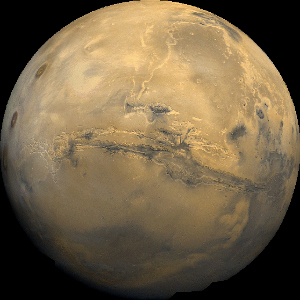Using satellite images, astronomers have identified features they say might have been carved by past glaciers as they flowed through the canyons but those claims have remained highly controversial and contested.
Now, a joint team from Bryn Mawr College and the Freie Universitaet Berlin has identified what could be the first mineralogical evidence of past glaciers within the Valles Marineris: a layer of mixed sulfate minerals halfway up the three-mile-high cliffs of Ius Chasma at the western end of the canyon system.

Valles Marineris on Mars. Credit: NASA
The team -- including Selby Cull (Bryn Mawr College), Patrick McGuire and Christoph Gross (Freie Universitaet Berlin), and Bryn Mawr undergraduate student researchers Jenna Myers and Nina Shmorhun -- mapped the acid-sulfate mineral jarosite along the canyon wall. They speculate that it may have formed via a mechanism similar to one observed at glaciers in the Svalbard on Earth: Atmospheric sulfur becomes trapped in the ice, is warmed by the sun, and reacts with the water to produce highly acidic sulfate minerals like jarosite along the margins of the glacier.
Citation: 'A new type of jarosite deposit on Mars: Evidence for past glaciation in Valles Marineris?
Selby Cull et al., Geology, 26 Sept. 2014, http://dx.doi.org/10.1130/G36152.1





Comments